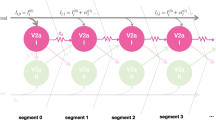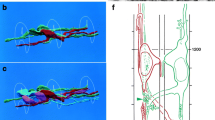Abstract
The extent and strength of long-distance coupling between locomotor networks in the rostral and caudal spinal cord of larval lamprey were examined with in vitro brain/spinal cord preparations, in which spinal locomotor activity was initiated by chemical microstimulation in the brain, as well as with computer modeling. When locomotor activity and short-distance coupling were blocked in the middle spinal cord for at least 40 segments, burst activity in the rostral and caudal spinal cord was still coupled 1:1, indicating that long-distance coupling is extensive. However, in the absence of short-distance coupling, intersegmental phase lags were not constant but decreased significantly with increasing cycle times, suggesting that long-distance coupling maintains a relatively constant delay rather than a constant phase lag between rostral and caudal bursts. In addition, under these conditions, intersegmental phase lags, measured between rostral and caudal burst activity, were significantly less than normal, and the decrease was greater for longer distances between rostral and caudal locomotor networks. The above result could be mimicked by a computer model consisting of pairs of oscillators in the rostral, middle, and caudal spinal cord that were connected by short- and long-distance coupling. With short-distance coupling blocked in the middle spinal cord, strychnine was applied to either the rostral or caudal spinal cord to convert the pattern locally from right-left alternation to synchronous burst activity. Synchronous burst activity in the rostral spinal cord resulted in a reduction in right-left phase values for burst activity in the caudal cord. These results also could be mimicked by the computer model. Strychnine-induced synchronous burst activity in the caudal spinal cord did not appear to alter the right-left phase values of rostral burst activity. Taken together, the experimental and modeling results suggest that the descending and ascending components of long-distance coupling, although producing qualitatively different effects, are comparatively weak. In particular, the descending component of long-distance coupling appears to become progressively weaker with increasing distance between two given regions of spinal cord. Therefore, short-distance coupling probably contributes substantially to normal rostrocaudal phase lags for locomotor activity along the spinal cord. However, short-distance coupling may be more extensive than ”nearest neighbor coupling.”
Similar content being viewed by others
Author information
Authors and Affiliations
Additional information
Received: 4 June 1998 / Accepted: 6 November 1998
Rights and permissions
About this article
Cite this article
McClellan, A., Hagevik, A. Coordination of spinal locomotor activity in the lamprey: long-distance coupling of spinal oscillators. Exp Brain Res 126, 93–108 (1999). https://doi.org/10.1007/s002210050719
Issue Date:
DOI: https://doi.org/10.1007/s002210050719




